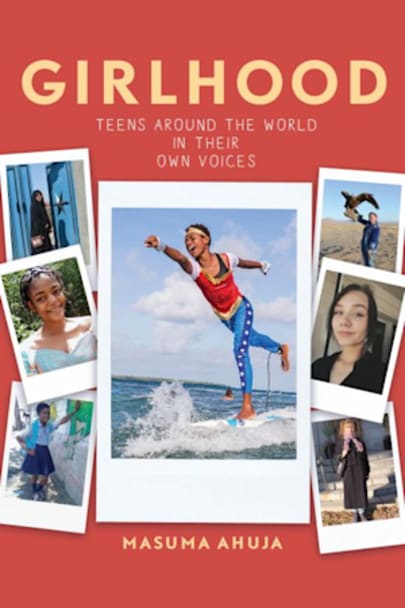What does a teenage girl dream about in Nigeria or New York? How does she spend her days in Mongolia, the Midwest, and the Middle East? All around the world, girls are going to school, working, dreaming up big futures–they are soccer players and surfers, ballerinas and chess champions. Yet we know so little about their daily lives. We often hear about challenges and catastrophes in the news, … catastrophes in the news, and about exceptional girls who make headlines. But even though the health, education, and success of girls so often determines the future of a community, we don’t know more about what life is like for the ordinary girls, the ones living outside the headlines.
From the Americas to Europe to Africa to Asia to the South Pacific, the thirty teens from twenty-seven countries in Girlhood share their own stories of growing up through diary entries and photographs, and the girls’ stories are put in context with reporting and research that helps us understand the circumstances and communities they live in. This full-color, exuberantly designed volume is a portrait of ordinary girlhood around the world, and of the world, as seen through girls’ eyes.
more



This is such an amazing book that celebrates the lives of young adults throughout the world. I remember that the only way I knew about what was happening with other young people my age outside of the United States back then was through a pen-pal who would send occasional photos about their lives half across the world from Asia, Europe and South America. This book definitely would have been something I would have loved to read during my teen years.
This book was phenomenally put together with lots of visuals and amazing photos of girls’ lives throughout the world across the continent of 31 young women and their life experiences, their passions, their interests that definitely spoke to me as a mother of a young teen girl.
I did read this and shared with my daughter who saw this book as eye – opening and more than interesting, that she took the book away from me and kept her nose devoured in this book in an afternoon. That just really warmed my heart. We all long for a sense of connection, and this book really did that for her. I was almost in tears.
Masuma Ahuja is a freelance journalist who did a fantastic job showcasing a variety of young women and highlighting their daily lives through their own voices. The pictures were fantastic as well as how the layout of the book with snippets like a scrapbook which made this fun and easy to read.
I absolutely recommend this book.
Ever wonder what girls in Mongolia like to do? Or wonder about the home lives of girls in Russia? Or what girls in Haiti dreaming of becoming when they are adults? This book answers those questions for us.
Thirty ordinary girls around the world were asked about their families, their friends, their school, and their daily lives. Overall, girls around the world are very much alike. They go to school, hang out with friends, post on social media, help their parents with chores. Their dreams are the same, but how they are attained differ. Some encounter challenges that impact their access to education and, oftentimes, their safety.
The girls in this book shared photographs and diary entries to allow us a peek into their daily lives. Did you know that about 5M students around the world travel to another country for education? Education is so readily available here in the US, but not so much in many other countries.
In many countries, the future of women’s rights remains uncertain. In Nigeria, education is forbidden by the group Boko Haram. In Afghanistan, laws and attitudes shift with the politics of the land. Estimated about 40% of all school-aged children there do not attend school, with about 85% of those being girls. In the Democratic Republic of the Congo, transport, water, and electricity are not always guaranteed. In Haiti, 13-year-old Merisena writes of days when her family cannot afford more than one meal a day, of lengthy power outages, and ongoing gang violence. Yet she has big dreams for the future.
Some of the girls have known nothing but conflict in their countries. Some fled their homes for a safer country, leaving behind their homes, friends, and most of their possessions. And while we see Baghdad as a place of war and conflict, 16-year-old Ruqaya sees it as shopping malls, exams at school, and long chats about marriage and life with friends. Some of the girls are dealing with gender identification and some with eating disorders. There is the universal fear of walking home after dark and the possibility of being attacked or worse.
I see this book as a valuable resource that should be in all school libraries.